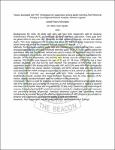| dc.description.abstract | Background: By 2030, all adults with HIV will have been dragonized, will be receiving
Antiretroviral Therapy (ART), and will have achieved viral load suppression. These goals form
the global effort to stop new HIV infections, increase treatment coverage, and end aids-related
deaths. This study investigated the variables that affect HIV RNA viral load suppression among
adults living with HIV at Lira Regional Referral Hospital in Uganda.
Methods: For this mixed-methods study, data was collected using a data extraction form, a semi structured questionnaire, and a key informant interview guide. STATA 17 was used to analyze the
quantitative data, and the thematic method was used to analyze the qualitative data. The results
were presented in charts, tables, and themes for quantitative data and qualitative data respectively.
Results: Of the 425 respondents, 235 (55.3%) were female and 190 (44.7%) were male. The
majority, 208 (48.9%) were between the ages of 31 and 40. Of those, 238 (56%) had at least
primary education, and 264 (62.1%) were married. The prevalence of HIV RNA viral non suppression was at 8.5% among adults living with HIV and 91.5% were HIN RNA virologically
suppressed. Recent cd4 counts, baseline viral load, and WHO clinical stage were significantly
associated with HIV RNA virological suppression. In addition to that, adherence (a OR=1.00, 95%
CI: 0.004-0.07, P=0.001) was associated with HIV RNA virological non-suppression.
Qualitatively, results revealed that status disclosure is always done by close relatives of the
victims, stigma, and discrimination were not common in the community.
Conclusion: There is a need for strategies on how to promote drug adherence among adults living
with HIV rather than just providing the treatment, as viral load suppression is related to baseline
viral load, CD4, marital status, and drug adherence. In this study, monitoring the immunological
response through scheduled CD4 and viral load tests is critical for maintaining patients’ immunity
and preventing disease progression. Intensive adherence support and counselling should
conclusively be provided through the effective implementation of ART programs by providers to
enhance viral suppression and ensure the quality of care and treatment.
Keywords: Non-Suppression, Adults Living with HIV, and Antiretroviral Therapy | en_US |

